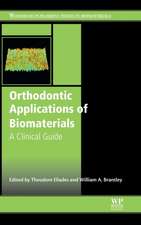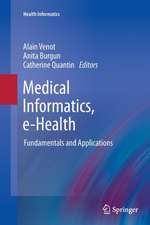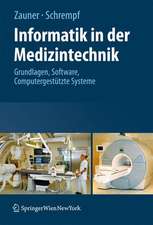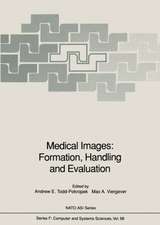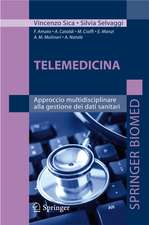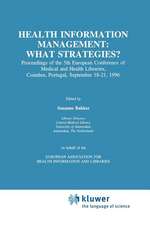Integration of Medical and Dental Care and Patient Data: Health Informatics
Editat de Amit Acharya, Valerie Powell, Miguel H. Torres-Urquidy, Robert H. Posteraro, Thankam Paul Thyvalikakathen Limba Engleză Hardback – mar 2019
This second edition of Integration of Medical and Dental Care and Patient Data details the available methods and technologies for successfully integrating patient medical and dental data. It is, therefore, an important and timely update for informaticians and a broad range of both dental and medical professionals and other health professionals (dental assistants, hygienists, nurses) as well as clinical students entering the professional environment.
Din seria Health Informatics
- 5%
 Preț: 429.40 lei
Preț: 429.40 lei - 5%
 Preț: 458.30 lei
Preț: 458.30 lei - 5%
 Preț: 326.78 lei
Preț: 326.78 lei - 5%
 Preț: 418.60 lei
Preț: 418.60 lei - 5%
 Preț: 353.44 lei
Preț: 353.44 lei - 5%
 Preț: 787.58 lei
Preț: 787.58 lei - 5%
 Preț: 1038.14 lei
Preț: 1038.14 lei - 5%
 Preț: 269.08 lei
Preț: 269.08 lei - 5%
 Preț: 488.26 lei
Preț: 488.26 lei - 5%
 Preț: 570.44 lei
Preț: 570.44 lei - 5%
 Preț: 404.76 lei
Preț: 404.76 lei - 5%
 Preț: 342.02 lei
Preț: 342.02 lei - 5%
 Preț: 416.37 lei
Preț: 416.37 lei - 5%
 Preț: 384.04 lei
Preț: 384.04 lei - 5%
 Preț: 341.47 lei
Preț: 341.47 lei - 5%
 Preț: 385.01 lei
Preț: 385.01 lei - 5%
 Preț: 363.07 lei
Preț: 363.07 lei - 5%
 Preț: 735.46 lei
Preț: 735.46 lei - 5%
 Preț: 769.80 lei
Preț: 769.80 lei -
 Preț: 384.86 lei
Preț: 384.86 lei - 5%
 Preț: 727.44 lei
Preț: 727.44 lei - 5%
 Preț: 719.74 lei
Preț: 719.74 lei - 5%
 Preț: 724.14 lei
Preț: 724.14 lei - 5%
 Preț: 649.68 lei
Preț: 649.68 lei - 5%
 Preț: 723.21 lei
Preț: 723.21 lei - 5%
 Preț: 589.18 lei
Preț: 589.18 lei - 5%
 Preț: 1104.48 lei
Preț: 1104.48 lei - 5%
 Preț: 366.70 lei
Preț: 366.70 lei - 5%
 Preț: 905.70 lei
Preț: 905.70 lei - 5%
 Preț: 717.00 lei
Preț: 717.00 lei - 5%
 Preț: 1122.94 lei
Preț: 1122.94 lei - 5%
 Preț: 731.80 lei
Preț: 731.80 lei - 5%
 Preț: 776.78 lei
Preț: 776.78 lei - 5%
 Preț: 844.27 lei
Preț: 844.27 lei - 5%
 Preț: 1102.10 lei
Preț: 1102.10 lei - 5%
 Preț: 380.25 lei
Preț: 380.25 lei - 5%
 Preț: 720.84 lei
Preț: 720.84 lei - 5%
 Preț: 771.30 lei
Preț: 771.30 lei - 5%
 Preț: 717.73 lei
Preț: 717.73 lei - 5%
 Preț: 388.48 lei
Preț: 388.48 lei - 5%
 Preț: 423.84 lei
Preț: 423.84 lei - 5%
 Preț: 724.50 lei
Preț: 724.50 lei
Preț: 992.21 lei
Preț vechi: 1044.42 lei
-5% Nou
Puncte Express: 1488
Preț estimativ în valută:
189.85€ • 198.76$ • 157.10£
189.85€ • 198.76$ • 157.10£
Carte tipărită la comandă
Livrare economică 02-08 aprilie
Preluare comenzi: 021 569.72.76
Specificații
ISBN-13: 9783319982960
ISBN-10: 3319982966
Pagini: 366
Ilustrații: XLVI, 350 p. 44 illus., 29 illus. in color.
Dimensiuni: 155 x 235 mm
Greutate: 0.91 kg
Ediția:2nd ed. 2019
Editura: Springer International Publishing
Colecția Springer
Seria Health Informatics
Locul publicării:Cham, Switzerland
ISBN-10: 3319982966
Pagini: 366
Ilustrații: XLVI, 350 p. 44 illus., 29 illus. in color.
Dimensiuni: 155 x 235 mm
Greutate: 0.91 kg
Ediția:2nd ed. 2019
Editura: Springer International Publishing
Colecția Springer
Seria Health Informatics
Locul publicării:Cham, Switzerland
Cuprins
Mouth: the Gateway to the Body and the Importance of Medical and Dental Data Integration.- Achieving the ‘True’ Triple Aim in Healthcare.- An Environmental Scan of the various Oral-Systemic Contact Points.- Interdisciplinary Care Model: Diabetes and Oral Health.- Interdisciplinary Care Model: Papillon- Lefèvre Syndrome and Oral Health.- Interdisciplinary Care Model: Cardiovascular Diseases and Oral Health.- Interdisciplinary Care Model: Chronic Kidney Disease and Oral Health.- Interdisciplinary Care Model: Odontogenic Infections and Systemic Complications.- Interdisciplinary Care Model: Pneumonia and Oral Health.- Interdisciplinary Care Model: Metabolic Syndrome and Oral Health.- Health Information Technology Considerations of Medical and Dental Data Integration.- Biosurveillance and Dentistry.- Knowledge Standardization, Management and Integration.- Economics of Clinical Data Integration.- The Need for Interprofessional Medical-Dental Education.- Integrated Care Case Study: Marshfield Clinic Health System.- Conclusion.- Appendix.- Index.
Notă biografică
Prof. Valerie Powell is presently a Professor at Robert Morris University and teaches discrete mathematics for IS professionals, networks and data communications, information security and assurance, as well as M programming for health care applications. Her present areas of research focus are on clinical data integration.
Amit Acharya, BDS, MS, PhD, is the Executive Director of the Marshfield Clinic Research Institute (MCRI) at Marshfield Clinic Health System (MCHS) in Wisconsin, USA. Dr. Acharya provides leadership and direction to support the mission and vision of the Institute as well as responsible for the oversight of the research operations. He subsequently serves as the Chief Dental Informatics Officer of the Family Health Center at MCHS and as a tenured Research Scientist at the Center for Oral and Systemic Health at MCRI. With over a decade of experience in the field of Health Information Technology, Health Informatics, and Clinical Research, Dr. Acharya is a well-regarded leader in dental informatics. As a general dental surgeon and a computer scientist with expertise in the field of biomedical informatics, Dr. Acharya’s research focus has been in the area of applied clinical informatics focusing on integration of medical and dental data, clinical and research information systems, design and architecture of electronic health records, developing clinical decision supports and investigating the oral-systemic relationship between periodontal and systemic disease such as diabetes, cardiovascular and respiratory diseases. He has served on the 2012 American Medical Informatics Association (AMIA) Scientific Programming Committee (SPC) and many other national committees. He has received multiple grant funding dedicated to bridging the medical and dental divide throughout the course of his career. Dr. Acharya has published over 100 scientific abstracts and manuscripts in national and international peer-reviewed journals and was also one of the editors of the first edition of this book - ‘Integration of Medical and Dental Care and Patient Data’.
Dr. Thankam Thyvalikakath is Director of Dental Informatics Core at the Indiana University School of Dentistry as well as a Research Scientist at the Center for Biomedical Informatics, Regenstrief Institute, Indianapolis, IN. As core director, she has established a program to enhance patient care through improved data capture and retrieval to assess treatment outcomes. Dr. Thyvalikakath earned her PhD degree in Biomedical Informatics from the University of Pittsburgh School of Medicine. She also holds a dental degree and certificate in clinical research from the University of Pittsburgh as well as a dental degree from the University of Kerala, India and a Master's degree in Oral & Maxillofacial Surgery from the University of Calicut, India. Dr. Thyvalikakath has served as Principal Investigator, co-investigator or consultant on numerous National Institutes of Health grants. Her research established foundational knowledge on applying user-centered design and cognitive engineering methods to design and evaluate clinical systems. Currently, she is leading a study supported through the National Dental Practice-based Research Network of the NIDCR to explore the feasibility of mining electronic dental records data from Network practices to assess treatment outcomes. In addition, she is co-investigator on a recent NIDCR funded study to implement clinical decision support for tobacco cessation in dental practices. Dr. Thyvalikakath also participates in clinical teaching and practice at the IU School of Dentistry. She has several publications, presentations and guest lectures to her credit and is a peer reviewer for five journals. She served as member of the American Medical Informatics Association (AMIA) task force to develop eligibility requirements for the Advance Health Informatics Certification (AHIC). She is alsoa past chair of the Dental Informatics Work Group at AMIA and Dental Informatics Section at American Dental Educators Association (ADEA). Currently, she serves in the AMIA Working Group Steering Committee (2018-2019) and Scientific Program Committee for the AMIA 2019 Informatics Summit.
Robert H. Posteraro, MD, MBI, FACR, is a Professor and Assistant Program Director in the Master of Science in Healthcare Administration (MSHA) program at Texas Tech University Health Sciences Center–School of Health Professions. Dr. Posteraro graduated Phi Beta Kappa, Magna Cum Laude, in cursu honorum, with a Bachelor of Science degree from Fordham College and earned his MD degree from Yale University School of Medicine. He did a fellowship in chest radiology at Yale, and a fellowship in magnetic resonance imaging at Duke. He earned his Master of Biomedical Informatics degree from Oregon Health & Science University. Prior to joining the MSHA faculty, Dr. Posteraropracticed radiology in both academic and private practice settings. He was Chairman of the Department of Radiology at Texas Tech University HSC School of Medicine. He continues to stay current in radiology and teaches radiation biology, radiation protection, and digital imaging, on a voluntary basis, at the Covenant School of Radiography, in Lubbock, TX. Dr. Posteraro has numerous publications, presentations, and guest lectures to his credit. He has been named Outstanding Faculty Member seven times, by the students in the MSHA program. He is a peer reviewer for three journals and is a member of the American Medical Informatics Association, and the Society for Imaging Informatics in Medicine. His current work is on the use and effects of informatics in distance education and the development of critical thinking skills in students.
Miguel Humberto Torres-Urquidy, D.D.S., M.S., Ph.D. (Candidate) is a Senior Service Fellow with the Centers for Disease Control and Prevention where he currently works with the medical Countermeasure Tracking System (CTS). Elements of CTS are used to distribute medical supplies to the general population during national public health emergencies. He served as acting Program Manager for BioSense (now the National Syndromic Surveillance Program or NSSP). As part of the NSSP he oversaw the Influenza-Like Illness, Hepatitis, and Opioid-Overdose Pilot Surveillance Projects. As Ebola responder he served as Senior Informatics Advisor for the CDC's Domestic Clinical Inquiries Team supporting US hospitals, clinics, and public health departments responsible for handling confirmed and suspected Ebola cases in the US. He first joined CDC as Informatics Fellow for CDC’s Influenza Division where he worked on facilitating access to CDC data by the general public by creating several visualization systems of influenza information. His work earned him the 2013 National Center for Immunization and Respiratory Diseases (NCIRD) Honor Award for “Excellence in Domestic Epidemiology” and the Best Poster Award at the International Society for Disease Surveillance Conference in 2010. Before joining CDC, he worked as post-doctoral associate at the Center for Dental Informatics at the University of Pittsburgh where he conducted NIH funded research focused on diagnostic terminologies. He also rotated with the NIH’s National Library of Medicine in 2004. During his rotation he conducted analyses on US public policy related to the establishment of the National Health Information Infrastructure. He is past chair of the Dental Informatics working group at the American Medical Informatics Association. He has published and also serves as reviewer in several major scientific journals, conferences, and government contract and grant review panels. Finally, he is one of the original editors of the first edition of this book.
Textul de pe ultima copertă
This largely revised second edition comprehensively reviews the need and rationale for the integration of medical and dental patient data. The reader will find extensive guidance on issues involved with care and data integration, and how to achieve an integrated model of healthcare. The book discusses how the use of state-of-the-art, fully integrated (dental-medical), electronic health records can improve clinical, financial as well as societal outcomes. In the book you will also find different aspects that play a role in integration including existing clinical software implementations (and their paths for integration), clinical touch points, and how current and future developments will facilitate the integration process in a more efficient way.
This second edition of Integration of Medical and Dental Care and Patient Data details the available methods and technologies for successfully integrating patient medical and dental data. It is, therefore, an important and timely update for informaticians and a broad range of both dental and medical professionals and other health professionals (dental assistants, hygienists, nurses) as well as clinical students entering the professional environment.
This second edition of Integration of Medical and Dental Care and Patient Data details the available methods and technologies for successfully integrating patient medical and dental data. It is, therefore, an important and timely update for informaticians and a broad range of both dental and medical professionals and other health professionals (dental assistants, hygienists, nurses) as well as clinical students entering the professional environment.
Caracteristici
Details the available methods and technologies for successfully integrating patient medical and dental data Provides a rationale for an integrative health care model Contains extensive guidance on avoiding potential issues surrounding data integration

